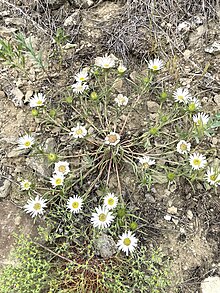Townsendia grandiflora
They are part of the Townsendia genus, which can be difficult for both amateur and expert botanists to correctly identify.
A short-lived plant, they are nonetheless grown by rock garden enthusiasts for their relatively large daisy-like flowers.
[3] The stems may be erect or lay on the ground and are covered in hairs that all point in the same direction (strigose).
[2] The ray flowers are predominately white,[2] but will often have a slight pink or purple tint or even be quite violet.
In their native habitat they bloom any time from June through August, with occasional stragglers still flowering in September.
[9] Townsendia grandiflora was given its first scientific description by the botanist Thomas Nuttall in a presentation read on 2 October 1840 to the American Philosophical Society.
[10][11] He described it as being from the "Black Hills, (or eastern chain of the Rocky Mountains)" and noted its attractive flowers, saying, "A plant which well deserves cultivation...".
[2] It grows wild in five states, South Dakota, Nebraska, Wyoming, Colorado, and New Mexico.
[19] It is commonly found on the dry slopes of foothills and mesas, in grasslands, and on eroded shales that contain gypsum.
[20][2] It often grows on sandy soils in Nebraska and Wyoming[21] or on strongly sloped clay banks in Colorado.
When a suitable soil is not available, they can grow in a mixture of equal parts well-composted leaves and sand.
They prefer half-sun conditions where they receive direct sun for only part of the day or a west facing position with shade from the south.

